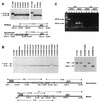Role of the promoter in maintaining transcriptionally active chromatin structure and DNA methylation patterns in vivo
- PMID: 12773559
- PMCID: PMC156144
- DOI: 10.1128/MCB.23.12.4150-4161.2003
Role of the promoter in maintaining transcriptionally active chromatin structure and DNA methylation patterns in vivo
Abstract
Establishment and maintenance of differential chromatin structure between transcriptionally competent and repressed genes are critical aspects of transcriptional regulation. The elements and mechanisms that mediate formation and maintenance of these chromatin states in vivo are not well understood. To examine the role of the promoter in maintaining chromatin structure and DNA methylation patterns of the transcriptionally active X-linked HPRT locus, 323 bp of the endogenous human HPRT promoter (from position -222 to +102 relative to the translation start site) was replaced by plasmid sequences by homologous recombination in cultured HT-1080 male fibrosarcoma cells. The targeted cells, which showed no detectable HPRT transcription, were then assayed for effects on DNase I hypersensitivity, general DNase I sensitivity, and DNA methylation patterns across the HPRT locus. In cells carrying the deletion, significantly diminished DNase I hypersensitivity in the 5' flanking region was observed compared to that in parental HT-1080 cells. However, general DNase I sensitivity and DNA methylation patterns were found to be very similar in the mutated cells and in the parental cells. These findings suggest that the promoter and active transcription play a relatively limited role in maintaining transcriptionally potentiated epigenetic states.
Figures







Similar articles
-
Nucleosomes are translationally positioned on the active allele and rotationally positioned on the inactive allele of the HPRT promoter.Mol Cell Biol. 2001 Nov;21(22):7682-95. doi: 10.1128/MCB.21.22.7682-7695.2001. Mol Cell Biol. 2001. PMID: 11604504 Free PMC article.
-
High-resolution methylation analysis of the human hypoxanthine phosphoribosyltransferase gene 5' region on the active and inactive X chromosomes: correlation with binding sites for transcription factors.Mol Cell Biol. 1994 Feb;14(2):1419-30. doi: 10.1128/mcb.14.2.1419-1430.1994. Mol Cell Biol. 1994. PMID: 8289817 Free PMC article.
-
The polyomavirus enhancer activates chromatin accessibility on integration into the HPRT gene.Mol Cell Biol. 1992 Dec;12(12):5785-92. doi: 10.1128/mcb.12.12.5785-5792.1992. Mol Cell Biol. 1992. PMID: 1333045 Free PMC article.
-
Regulation of the hypoxanthine phosphoribosyltransferase gene: in vitro and in vivo approaches.Proc Soc Exp Biol Med. 1996 Jun;212(2):116-27. doi: 10.3181/00379727-212-43998. Proc Soc Exp Biol Med. 1996. PMID: 8650248 Review.
-
Aberrant patterns of DNA methylation, chromatin formation and gene expression in cancer.Hum Mol Genet. 2001 Apr;10(7):687-92. doi: 10.1093/hmg/10.7.687. Hum Mol Genet. 2001. PMID: 11257100 Review.
Cited by
-
Cytostatic drug treatment causes seeding of gene promoter methylation.Eur J Cancer. 2007 Mar;43(5):947-54. doi: 10.1016/j.ejca.2006.12.003. Epub 2007 Jan 22. Eur J Cancer. 2007. PMID: 17236756 Free PMC article.
-
Regulatory elements associated with paternally-expressed genes in the imprinted murine Angelman/Prader-Willi syndrome domain.PLoS One. 2013;8(2):e52390. doi: 10.1371/journal.pone.0052390. Epub 2013 Feb 4. PLoS One. 2013. PMID: 23390487 Free PMC article.
-
Recruitment of transcription complexes to the beta-globin gene locus in vivo and in vitro.J Biol Chem. 2004 Nov 26;279(48):50350-7. doi: 10.1074/jbc.M408883200. Epub 2004 Sep 22. J Biol Chem. 2004. PMID: 15385559 Free PMC article.
-
High rate of mutation reporter gene inactivation during human T cell proliferation.Immunogenetics. 2007 Feb;59(2):135-43. doi: 10.1007/s00251-006-0180-8. Epub 2006 Dec 19. Immunogenetics. 2007. PMID: 17180623
-
Genome-Wide Analysis Unveils DNA Helicase RECQ1 as a Regulator of Estrogen Response Pathway in Breast Cancer Cells.Mol Cell Biol. 2021 Mar 24;41(4):e00515-20. doi: 10.1128/MCB.00515-20. Print 2021 Mar 24. Mol Cell Biol. 2021. PMID: 33468559 Free PMC article.
References
-
- Bender, M. A., M. Bulger, J. Close, and M. Groudine. 2000. Beta-globin gene switching and DNase I sensitivity of the endogenous beta-globin locus in mice do not require the locus control region. Mol. Cell 5:387-393. - PubMed
-
- Brandeis, M., D. Frank, I. Keshet, Z. Siegfried, M. Mendelsohn, A. Nemes, V. Temper, A. Razin, and H. Cedar. 1994. Sp1 elements protect a CpG island from de novo methylation. Nature 371:435-438. - PubMed
-
- Brown, C. J., A. Ballabio, J. L. Rupert, R. G. Lafreniere, M. Grompe, R. Tonlorenzi, and H. F. Willard. 1991. A gene from the region of the human X inactivation centre is expressed exclusively from the inactive X chromosome. Nature 349:38-44. - PubMed
Publication types
MeSH terms
Substances
Grants and funding
LinkOut - more resources
Full Text Sources
Other Literature Sources
Miscellaneous
